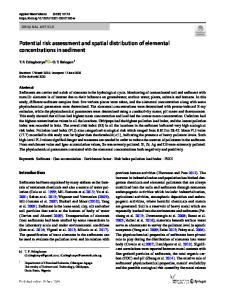Ecological risk assessment of heavy metal concentrations in sediment and fish of a shallow lake: a case study of Baiyang
- PDF / 1,200,663 Bytes
- 16 Pages / 547.087 x 737.008 pts Page_size
- 83 Downloads / 330 Views
Ecological risk assessment of heavy metal concentrations in sediment and fish of a shallow lake: a case study of Baiyangdian Lake, North China Teklit Zerizghi & Yufeng Yang & Wenjun Wang & Yang Zhou & Jin Zhang & Yujun Yi
Received: 19 June 2019 / Accepted: 8 January 2020 # Springer Nature Switzerland AG 2020
Abstract The pollution levels of lakes vary in quantity and type of contaminants accumulated in their sediment and water. The second Chinese capital city will be built around Baiyangdian Lake in the near future, and thus, it is important to monitor pollution status of Baiyangdian Lake. This study mainly focused on the accumulated heavy metal concentrations in the surface sediment and in variety of fish bodies. Sediment pollution status and ecological risk were evaluated through geoaccumulation (I-geo), contamination factor (CF), pollution load index (PLI), potential ecological risk (Eir ), and mean probable effect concentration quotient (mPEC-Q). In addition, human health risks via fish consumption were also evaluated. Based on the results, the average sediment trace As, Cd, Cr, Cu, Mn, Ni, Pb, and Zn concentrations were 9.53, 0.35, 56.37, 32.33, 617.05, 30.18, 19.17, and 84.24 mg/kg dry wt, respectively. Both I-geo and E ir inferred low pollution levels and low ecological risks from all assessed trace metals except Cd. Cd posed moderate to high ecological risks. Based on sediment quality guidelines (SQGs), average Ni and Cr concentrations exceeded the threshold effect concentrations (TEC), but their E ir are low as their average concentrations is below Hebei province pre-
contaminations (30.8 mg/kg for Ni and 68.3 mg/kg for Cr). There is no cumulative toxicity from all the metals through mPEC-Q. Omnivorous fish accumulated statistically insignificantly higher amounts of metals than carnivorous fish, except for Hg. The intake of 12.22 g/ person/day fish muscle for the entire life is safe from noncarcinogenic human health problems.
T. Zerizghi : J. Zhang : Y. Yi School of Civil Engineering, Yantai University, Yantai, China
T. Zerizghi : Y. Yang : W. Wang : Y. Zhou : Y. Yi (*) State Key Laboratory of Water Environment Simulation, School of Environment, Beijing Normal University, Beijing 100875, China e-mail: [email protected]
Keywords Potential ecological risk . fish consumption health risk . geo-accumulation index . dietary intakes
Introduction Lakes are freshwater sources with vital ecosystem services, such as habitat provision for aquatic organisms, water table retention, biodiversity preservation, and climate regulation (Yang et al. 2010; Guo et al. 2011; Zhao et al. 2012a, b). They also have substantial economic contributions for nearby residents. However, they store various environmentally released contaminants. Multiple pollutant continuous enrichment in aquatic environments degrades water and sediment qualities and triggers health problems for biota. Normally, sediment is
154
Page 2 of 16
considered polluted if concentrations of the trace pollutants exceed their corresponding pre-pollution con
Data Loading...











